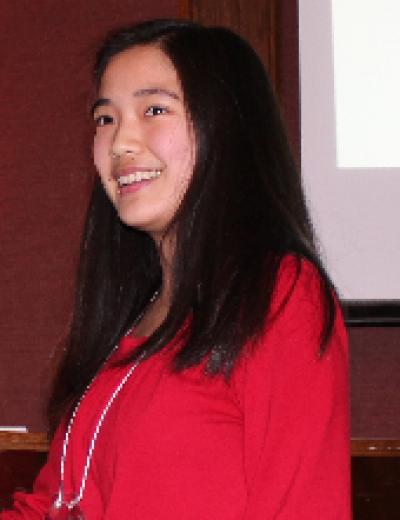Janelle Tam took top honors at the 2012 Sanofi BioGENEius Challenge Canada. Her super anti-oxidant compound could one day help improve health and anti-aging products by neutralizing harmful free-radicals found in the body. Tam, a Grade 12 student at Waterloo Collegiate Institute, was awarded the $5,000 first prize by Canadian scientists assembled at the Ottawa headquarters of the National Research Council of Canada. Her competition was 13 students in Grades 11 or 12, who were top prize winners of nine regional SBCC competitions conducted nationwide in March and April.
The theme of the competition, "How will you change the world?" inspired hundreds of students to participate in 2012 SBCC events Canada-wide.

16-year-old Janelle Tam Ontario created a super-charged anti-oxidant compound using nano-particles from trees, winning the 2012 Sanofi BioGENEius Challenge Canada. Credit: Sanofi BioGENEius Challenge Canada
Cellulose, woody material found in trees that enables them to stand, is made up of tiny nano-particles called nano-crystalline cellulose (NCC) that are measured in thousandths of the width of a human hair. Only recently discovered, Waterloo's Janelle Tam is the first to show that NCC is a powerful antioxidant, and may be superior to Vitamin C or E because it is more stable and its effectiveness won't diminish as quickly.
"NCC is non-toxic, stable, soluble in water and renewable, since it comes from trees," says Tam. NCC has many unique properties: stronger than steel but flexible, durable and ultra light. Its potential uses are virtually limitless. Canada's national forest research institute, FPInnovations, predicts a $250 million dollar market in the coming decade. The world's first large-scale NCC production plant opened in January at a pulp and paper mill in Windsor, Quebec. NCC is extracted from cellulose using a chemical process similar to that used in pulp mills.
Tam chemically 'paired' NCC with the well-known nanoparticle buckminster fullerene. These 'buckyballs' (carbon molecules that look like a soccer ball) are already used in cosmetic and anti-aging products she says. The new NCC-buckyball combination acted like a 'nano-vacuum,' sucking up free radicals and neutralizing them.
"The results were really exciting," she says and especially since cellulose is already used as filler and stabilizer in many vitamin products. One day those products may be super-charged free radical neutralizers thanks to NCC, she hopes.
2nd place ($4,000), was awarded to Rui Song, 16, a Grade 11 student from Walter Murray Collegiate, Saskatoon, for developing new insights into the potential creation of a more nutritious lentil (project profile: http://bit.ly/IrvD9I ). It is Rui's second major award at the national SBCC; she won first prize in 2010 when she was in Grade 9.
3rd place ($3,000): Alexander Tigert and Zelun (Daniel) Zhang, both 17, Grade 12, Northern Secondary School, who used genetically-modified Baker's yeast to create a novel environment for testing the effects of drug treatments for depression and anxiety. Project profile: http://bit.ly/IjfNoa
4th place ($2,000): Ella Thomson, 16, Grade 11, Balmoral Hall School, Winnipeg, who genetically modified a common soil bacteria to produce 36% more volume of the bio-ingredient used to make eco-friendly plastic. Project profile: http://bit.ly/IAd0Vn
5th place ($1,000): Romina Hassanzadeh, 17, Grade 12, All Saints Catholic High School, Kanata, who puzzled out a new insight into the workings of a cancer-fighting drug, a discovery that could one day impact medical approaches to cancer treatment. Project profile: http://bit.ly/ICpjzR
A special $1,000 prize for the project deemed to have the greatest commercial potential was awarded to Miranda Wang, 18, and Jeanny Yao, 17, both Grade 12, Magee Secondary School, Vancouver, who identified soil bacteria from the Fraser River estuary that naturally break down phthalates, a fossil fuel-based additive found in some plastics.
The girls have already approached firms in British Columbia and Ontario on potential commercialization ideas. Project profile: http://bit.ly/Jdt1vY
Each of the students worked for months conducting research and collaborating with university mentors.
The nine national finalists presented their projects at NRC headquarters Monday May 7 to a panel of eminent Canadian scientists:
Dr. Luis Barreto (Chief Judge), Senior Advisor, Vaccine Program, Human Health and Therapeutics, National Research Council Canada, and ex-Vice President, Immunization and Science Policy, Sanofi Pasteur Limited;
Dr. Jim Richards, Director General, Vaccine Program, Human Health and Therapeutics, National Research Council Canada;
Dr. Alain Beaudet, President, Canadian Institutes of Health Research;
Dr. Ron Pearlman, Associate Scientific Director, The Gairdner Foundation;
Dr. John Kelly, Vice-President, Erie Innovation and Commercialization, Ontario Fruit&Vegetable Growers' Association; and
Dr. Alison Symington, Vice President, Outreach, Ontario Genomics Institute.
Also on the judging panel was Marshall Zhang, 18, of Richmond Hill Collegiate, national first-place winner of the SBCC in 2011.
"Every young person that gets to this level of competition is a winner and I congratulate them equally," said chief judge Luis Barreto. "Credit goes to all the students and mentors from coast to coast who took part in this year's event. There is great talent across our country. Every one of the participants and their talent left the judges in genuine delight."
The award ceremony at the NRC also included a special presentation honouring the contribution to SBCC of Jeff Graham of Toronto, Chair and President of Bioscience Education Canada, which has coordinated the competition from its beginning in 1994.






Comments